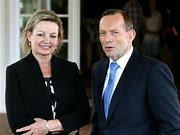In the intricate world of politics, every move can trigger a storm. Picture this: Tony Abbott, a prominent figure in Australian politics, is making waves with his latest demand directed at Opposition Leader Sussan Ley. The stakes are high as a deadline looms for Ley to navigate through factional tensions within the New South Wales (NSW) division of the Liberal Party.
Abbott is pushing Ley to stay the course set by Peter Dutton in revamping the troubled state outfit, setting the stage for a clash that could deepen existing divides within the party. This challenge comes hot on the heels of Ley’s recent reshuffle that ruffled feathers and tested her authority right out of the gate.
The heart of this power struggle lies in an intervention initiated back in September when Dutton and other party leaders greenlit efforts to take over control from NSW members due to operational mishaps. The failure to field candidates for local elections raised red flags about the branch’s efficiency, prompting calls for reform.
As tension simmers in NSW, recent internal strife between Ley’s camp and the Nationals adds another layer of complexity. A delicate truce was struck after days of discord, resulting in an altered frontbench that pleased some but left others disgruntled. It’s a chess game where strategic appointments aim to balance talent with loyalty.
Amidst all this drama, Abbott’s voice cuts through as he urges Ley to rise above factional interests and prioritize party unity over personal allegiances. His call for extending the federal intervention underscores his vision of a more inclusive and transparent political landscape where every member has a voice.
“It’s always important for the parliamentary leadership to be bigger than any faction,”
remarked Abbott pointedly. He emphasizes moving beyond past favors and focusing on what serves the greater good rather than settling old scores—a message that resonates loudly amidst brewing tensions.
While factions jostle for influence behind closed doors, grassroots members are watching closely as administrators lay out plans to revamp party structures and processes. There’s a push towards democratizing decision-making and diluting entrenched power dynamics—a move welcomed by those seeking a more participatory political culture.
Abbott’s decades-long advocacy for opening up factional strongholds within the party reflects a broader desire for renewal and inclusivity among rank-and-file members. His critique of closed-door dealings echoes sentiments shared by many who yearn for more transparency and accountability in political operations.
As Ley grapples with multiple fronts—internal dissent, external pressures, and looming decisions—the road ahead is fraught with challenges that will test not only her leadership skills but also her ability to navigate treacherous political waters. Each move she makes will reverberate across party lines and shape its future trajectory.
In this high-stakes game of power dynamics and ideological clashes, one thing remains clear: navigating factional fault lines requires finesse, foresight, and fortitude—a balancing act that could determine not just individual fates but also reshape the broader political landscape.

